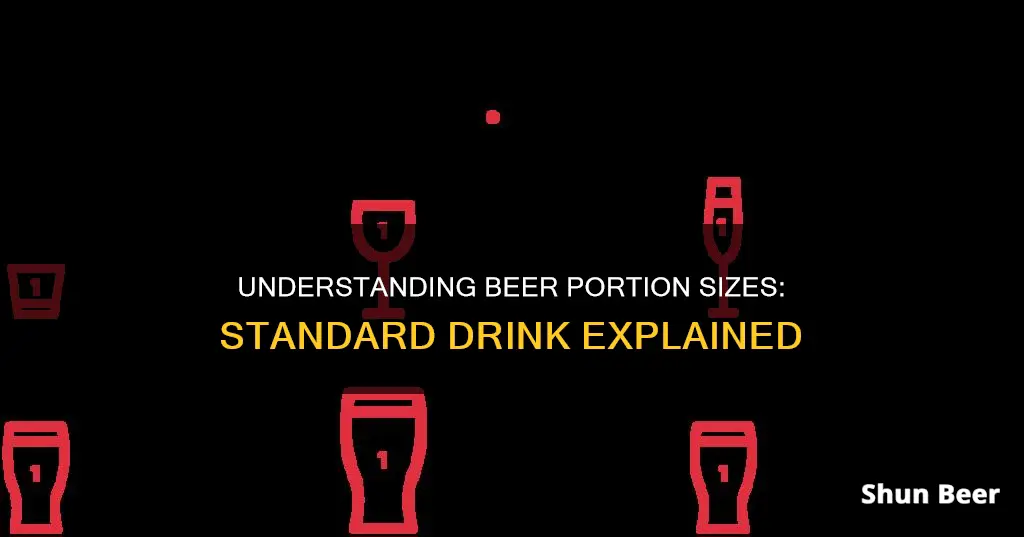
A standard drink of beer is a measure of alcohol consumption that helps educate users about the relative risks of drinking to their health. While there is no international consensus on how much pure alcohol is contained in a standard drink, in the United States, a standard drink of beer is defined as 0.6 fluid ounces or 14 grams of pure alcohol, typically found in a 12-ounce can or bottle of 5% alcohol beer. This amount of alcohol can be metabolized by the liver in about an hour, and understanding standard drink sizes can help individuals make informed decisions about their alcohol consumption to maintain their health.
| Characteristics | Values |
|---|---|
| Definition | A "standard drink" of beer is defined as any beverage containing 0.6 fluid ounces or 14 grams of pure alcohol. |
| Volume | A standard drink of beer varies in volume depending on the alcohol concentration of the beverage. |
| Examples | A 12 fl oz can of 5% alcohol beer, an 8–10 fl oz glass of malt liquor or flavored malt beverages such as hard seltzer, a 375 ml can of full-strength beer (4.8% alcohol) |
What You'll Learn

A standard drink is 0.6 fl oz of pure alcohol
In the United States, a "standard drink" is defined as any beverage containing 0.6 fluid ounces (or 14 grams) of pure alcohol. This is also known as an alcoholic drink equivalent. This definition is important because it helps people understand how much alcohol they are consuming, regardless of the type or size of the drink.
A standard drink always contains the same amount of alcohol, so it will produce the same level of drunkenness across different beverage types. For example, a standard drink of spirits will take up much less space than a standard drink of beer, but they will contain the same amount of alcohol. This is because the amount of pure alcohol in each drink depends on the alcohol content, or the percentage of alcohol by volume (ABV).
In the US, a standard drink is equivalent to 12 fluid ounces of regular beer, which is typically about 5% alcohol. However, craft beers may contain 8-10% alcohol or more, so the same volume would count as more than one standard drink. Similarly, a standard drink of wine is 5 fluid ounces, as it usually has a higher alcohol content of around 12%.
It's worth noting that a "single serving" drink may be equivalent to two or more standard drinks, depending on the glass or container size. For example, a shot of distilled spirits (such as brandy, gin, rum, tequila, vodka, or whiskey) is typically 1.5 fluid ounces and counts as one standard drink. But a mixed drink made with liquor can be more challenging to estimate, as it depends on factors such as the type of spirit and the recipe.
Understanding standard drink sizes is crucial for making informed decisions about alcohol consumption and following health guidelines. It's important to remember that the percentage of pure alcohol can vary within and across beverage types, and customary serving sizes may not reflect standard drink amounts.
Beer and Pepto-Bismol: A Safe Mix?
You may want to see also

Domestic beer is 5% alcohol, sold in 12-ounce cans or bottles
Domestic beer typically contains 5% alcohol and is sold in 12-ounce cans or bottles. This is considered a "standard drink" in the United States, defined as any beverage containing 0.6 fluid ounces or 14 grams of pure alcohol. Understanding the alcohol content of beer is important for responsible consumption and preventing negative consequences associated with heavy drinking.
The alcohol content in beer varies, ranging from light beers with 4-5% alcohol by volume (ABV) to regular beers with 5-6% ABV. Craft beers can have a wider range, typically falling between 6-10% ABV. Stronger styles, such as double IPAs and imperial stouts, can have even higher ABV levels, reaching 15% or more.
The ABV of a beer is determined by the fermentation process, specifically the duration of fermentation, which impacts the amount of alcohol produced. Knowing the ABV of a beer helps individuals estimate its potential effects on their bodies. For example, a stronger beer with a higher ABV may be equivalent to several standard drinks, requiring careful monitoring of alcohol consumption.
In the United States, the Alcohol and Tobacco Tax and Trade Bureau (TTB) defines beer as ales, porters, stouts, sake, and similar fermented beverages with an ABV of 0.5% or higher. While the federal threshold for beer is an ABV above 0.5%, each state sets its own limits on the alcohol content of beer sold within its borders. For instance, Utah and Colorado limit beer to 4% ABV, while Vermont allows up to 16% ABV.
It's important to note that the percentage of alcohol in beer can vary not only between different types of beer but also between different countries. For example, German beers typically have higher ABV levels than Asian beers, with Chinese beer typically containing around 3% ABV. Regardless of the ABV, understanding the alcohol content of beer is crucial for making informed decisions about drinking habits and potential health risks.
Beer After Laparoscopic Gastrectomy: What You Should Know
You may want to see also

Craft beers contain 8-10% alcohol or more
The alcohol content of beer varies depending on the type and brewing process. Generally, light beers contain between 4% and 5% ABV, while regular beers contain between 5% and 6% ABV. However, craft beers tend to have a higher ABV, typically ranging from 6% to 10%. Some craft beers, such as double IPAs and imperial stouts, can have an ABV as high as 15% or more.
Craft beers with an ABV of 8% to 10% or more are considered strong beers. A higher ABV means that a person will reach the same level of intoxication with fewer drinks. For example, a 12-ounce serving of an 8% ABV craft beer contains 0.96 ounces of pure alcohol, which is equivalent to 1.6 standard drinks. This means that drinking two 12-ounce bottles of an 8% ABV craft beer is equivalent to consuming 3.2 standard drinks, which is well above the recommended daily limit.
It is important to understand the alcohol content of craft beers to ensure responsible consumption and avoid the negative consequences of heavy drinking. The ABV of a beer is listed on the label, allowing consumers to make informed decisions about their drinking habits and prevent potential health risks. Drinking high-ABV beers can be harmful if consumption is not carefully monitored.
In addition to the ABV, the volume of the drink also affects the amount of alcohol consumed. For example, a 16-ounce pint of a 5% ABV beer is equivalent to 1.3 standard drinks, while a pint of 7% ABV beer is equivalent to 1.82 standard drinks. Consuming larger volumes of higher-ABV beer can significantly increase the amount of alcohol ingested.
To maintain optimal health, it is recommended to consume alcohol in moderation. According to the 2015-2020 U.S. Dietary Guidelines, women of legal age should consume no more than one standard drink per day, while men of legal age should consume no more than two standard drinks per day. Understanding standard drink sizes and alcohol content can help individuals make informed decisions about their alcohol consumption and prevent overconsumption.
Garlic and Beer: A Healthy Mix?
You may want to see also

A standard drink of spirits takes up less space than beer
A standard drink is a measure of alcohol consumption that helps educate users about the relative risks of alcohol to their health. It represents a fixed amount of pure alcohol, and while the notion is used globally, the definition of a standard drink varies from country to country. In the United States, a standard drink is defined as 0.6 fluid ounces or 14 grams of pure alcohol. This is equivalent to 12 fluid ounces of regular beer, 5 fluid ounces of table wine, or 1.5 fluid ounces of distilled spirits.
The volume of a standard drink varies depending on the alcohol concentration of the beverage. For example, a standard drink of spirits will take up much less space than a standard drink of beer. This is because spirits have a higher alcohol content than beer, so less liquid is needed to reach the same amount of pure alcohol.
To illustrate, consider a standard drink of beer, which is typically around 12 fluid ounces. This volume is necessary to provide 0.6 fluid ounces or 14 grams of pure alcohol, the amount in a standard drink. On the other hand, a standard drink of spirits, such as vodka or whiskey, is usually just 1.5 fluid ounces. Despite the smaller volume, this shot of spirits contains the same amount of pure alcohol as the 12-ounce beer.
The difference in volume between a standard drink of spirits and beer is due to their varying alcohol concentrations. Spirits are highly concentrated forms of alcohol, with liquor typically containing 40% alcohol (80-proof). In contrast, beer usually has a lower alcohol content, with domestic beers averaging around 5% alcohol. Therefore, a much smaller volume of spirits is required to match the amount of pure alcohol in a standard drink of beer.
Understanding the concept of standard drinks is essential for making informed decisions about alcohol consumption. It allows individuals to track their alcohol intake and be mindful of the potential health risks associated with excessive drinking. By knowing that a standard drink of spirits takes up less space than beer, individuals can better gauge their consumption and make responsible choices when consuming alcoholic beverages.
Getting Older: Beer and Me
You may want to see also

Alcoholic drinks vary in type, size, and alcohol content
For example, a standard drink of beer is 12 fluid ounces with 5% alcohol content. However, light beers typically have an alcohol content of around 4.2%, which is 85% of that found in regular beer. Similarly, malt liquor has a higher alcohol content than regular beer, with 7% alcohol content in an 8-ounce serving.
Wine also varies in alcohol content. A standard drink of wine is 5 fluid ounces with 12% alcohol content. However, champagne typically has an alcohol content of 10-12%, while fortified wines like port, sherry, and vermouth have a much higher alcohol content of around 20%.
Distilled drinks, also known as liquors or spirits, have a higher alcohol content than fermented drinks like beer and wine. A standard drink of distilled liquor is 1.5 fluid ounces with 40% alcohol content. Gin, for instance, typically has an alcohol content ranging from 35-55%, while rum usually has an alcohol content of 40%.
Different types of alcoholic drinks have varying concentrations of alcohol, which can affect how quickly and in what doses drunkenness or alcohol poisoning can occur. It is important to be aware of the alcohol content of drinks and understand that one beer or cocktail may not equal one standard drink.
Good Friday Beer: Is It Allowed?
You may want to see also
Frequently asked questions
In the US, a standard drink of beer is 12 fl oz of regular beer with 5% alcohol.
In the US, a standard drink is defined as 0.6 fluid ounces or 14 grams of pure alcohol.
A standard 750-ml bottle of beer contains approximately 5 standard drinks.
A pint of beer (16 US fl oz) contains 1 standard drink.







